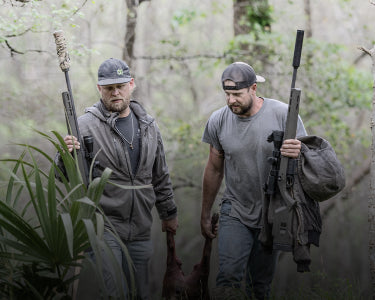Deep in the beautiful mountains of Oklahoma, I find my second home. I feel like I imagine our ancestors must have felt—at peace and one with nature. Cooking over a campfire, with the only light being the moon and stars, seeing wildlife in their natural habitat, and falling asleep under the stars to the sounds of nature—this is where I feel most human and at home.
Why I Chose to Start Tracking Black Bear
I’m not big into hunting, but I love shooting, especially long-range. I love being outdoors, learning new bushcraft skills, building different types of shelters, and watching animals. A big part of my love for the outdoors is tracking—looking for signs of animal activity like prints, markings on trees, broken branches, and scat, to name a few. This led me to want to track black bears, as I had never seen a bear in real life. My knowledge of bears was limited to the fact that you’d lose a fight every time, and the brown ones are more aggressive. I have a very high respect for bears, mainly out of a lack of knowledge and fear. But it's time to change that.
I set out into the woods of the Oklahoma mountains with a plan:
- Find signs of bears
- Feed the bears
- Video the bears
- Go home with all fingers and toes
I checked local laws, and I found I was good to go because I wasn’t hunting to shoot them with my rifle, but rather with my camera. Now I admit, I looked a little suspicious since I was armed, but I followed all local laws and regulations.
Reading Signs and Setting Bait
There were lots of pine trees in the densely wooded mountains, and as such, the forest floor was full of pine needles, making walking through the woods much quieter. However, it was also challenging, if not impossible, to find bear tracks. My best bet was to find trails and look for bear scat. Luckily, it didn't take long. A large pile of bear scat lay in the middle of a big clearing. This bear had been eating some berries. The scat was dry on top, but with it being 100ºF, it could have been four hours or two days old, and my knowledge of scat is limited, so I had no idea how old it was. However, I do know that black bears are most active at dusk and dawn. Part two of my plan was to get some berry or fruit-flavored corn and give the bear a reason to return. I planned to return about an hour before dusk.
I returned to my truck to get a shovel and sweet corn. Now I had to carry a 40lb bag of corn, a shovel, and my firearm back through the thick woods. Did I mention that it was 100ºF? It was definitely not fun, but I reckoned it’d be worth it if everything worked out. I dug a shallow but large hole in the ground and filled it with the sweet smell of berry-flavored corn. I used about half the bag to fill the hole and scattered the rest around a large area to get the sweet aroma to fill the air, hoping to draw the bear in. Also, I did not want to carry a bag of corn back through the woods. I thought this would be the safest way to see a bear as I was mindful of a bear with cubs. As much as I would love to see a mama and her young ones, I feared that if I ran into them, it’d probably be hazardous to my health. After the hard work was done, it was time to head back to camp for a meal.
Preparing for a Nighttime Bear Encounter
I gathered kindling and wood to get a nice fire going. That night’s meal was vegetarian garlic chicken Alfredo with angel hair pasta—or, as I call it, grass chicken Alfredo. My girlfriend grilled the grass chicken while I made the pasta over the open fire. We had a beautiful meal by the fire and relaxed until it was time to set out on our journey to see if we could find the beautiful black bears of the Ouachita mountains.

My firearm of choice is a Remington 700 in .300 Blackout, topped with Sightmark's Wraith Mini Thermal—my camera. Since my optic records audio and video, and happens to be attached to a rifle, it was the safest, most logical way to get my bear footage. I dressed in Sitka sub-alpine camo and returned to where I had placed the corn. With safety being my first priority, I chose to sit upwind of the corn pile with my back to a large group of small, tightly clustered trees. I thought about what’d happen if the bear smelled me, and risking it not coming in at all would be safer than having it come in from behind me. Luckily for me, it worked! After about three hours, a large male black bear came in.

I was in awe that the bear made no more noise walking in than the trees blowing in the wind. He plopped down on his belly like a little kid and smacked on the corn. This was it! I was seeing a bear in real life, even if only through a thermal scope. After eating for a few minutes, he sat up to stretch and then plopped right back down to continue eating. I thought I was either crazy or stupid, but either way, I was, at that point, sitting 25 yards from a hungry bear. Only then did I think, "I can’t move until he’s done eating and leaves!" Did I think this whole thing through? After about 30 minutes, the majestic creature stood up on all fours, took a look around, and started to walk off. He walked about ten yards and turned his head to look directly at me, as if to say, “See you later.” And just as silently as he entered, he disappeared off into the woods.
OH MY GOODNESS! DID THAT REALLY HAPPEN? I asked myself. Indeed, it did, and now I have the video to prove it. My respect for bears has grown, and I now understand just how amazing these beautiful animals are. Bears are very powerful creatures, and they deserve our respect and some space. Every outdoorsman needs to have a basic understanding of wildlife; you want to avoid ending up face-to-face with a bear—or any dangerous animal, for that matter.
Have a great outdoor adventure story? Share it with us! Accepted stories will receive a 20% discount code.
Frequently Asked Questions
What led the author to start tracking black bears in Oklahoma?
The author's love for the outdoors, interest in tracking animal activity, and desire to see a bear in real life led them to start tracking black bears.
What precautions did the author take to ensure they were following local laws while tracking black bears?
The author made sure they were not hunting the bears with a rifle, but rather with a camera. They also checked local laws and regulations to ensure they were in compliance.
What signs did the author look for to track black bears in the Oklahoma mountains?
The author looked for bear scat and trails as signs of black bear activity in the mountains. They also mentioned that black bears are most active at dusk and dawn.
How did the author plan to attract the black bear back to the area?
The author planned to set bait by digging a hole in the ground and filling it with berry-flavored corn. They scattered the rest of the corn around a large area to draw the bear in with the sweet aroma.
What time of day are black bears most active according to the author?
Black bears are most active at dusk and dawn, as mentioned by the author in their tracking experience in the Oklahoma mountains.



